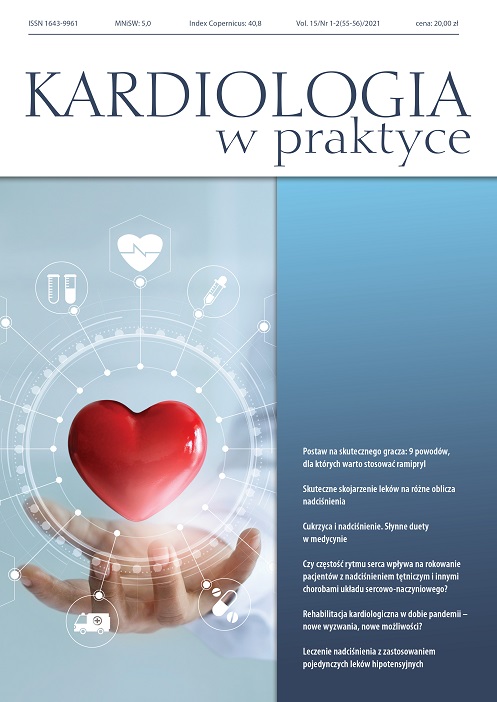Leczenie nadciśnienia z zastosowaniem pojedynczych leków hipotensyjnych Artykuł przeglądowy
##plugins.themes.bootstrap3.article.main##
Abstrakt
Aktualne wytyczne zalecają u większości pacjentów wdrażanie terapii od leku złożonego zawierającego dwa składniki. Rozpoczynanie leczenia od jednego leku rekomenduje się w określonych sytuacjach. Monoterapia jest wskazana u pacjentów z nadciśnieniem tętniczym pierwszego stopnia ze skurczowym ciśnieniem tętniczym < 150 mmHg z niskim do umiarkowanego ryzykiem sercowo-naczyniowym oraz pacjentów z wysokim prawidłowym ciśnieniem tętniczym z bardzo wysokim ryzykiem sercowo-naczyniowym. Zaleca się monoterapię osób starszych z zespołem kruchości.
Pobrania
##plugins.themes.bootstrap3.article.details##

Utwór dostępny jest na licencji Creative Commons Uznanie autorstwa – Użycie niekomercyjne – Bez utworów zależnych 4.0 Międzynarodowe.
Copyright: © Medical Education sp. z o.o. This is an Open Access article distributed under the terms of the Attribution-NonCommercial 4.0 International (CC BY-NC 4.0). License (https://creativecommons.org/licenses/by-nc/4.0/), allowing third parties to copy and redistribute the material in any medium or format and to remix, transform, and build upon the material, provided the original work is properly cited and states its license.
Address reprint requests to: Medical Education, Marcin Kuźma (marcin.kuzma@mededu.pl)
Bibliografia
2. Polskie Towarzystwo Nadciśnienia Tętniczego. Zasady postępowania w nadciśnieniu tętniczym – 2019 rok. Nadciśnienie Tętnicze w Praktyce. 2019; 5(1): 1-86.
3. Szyndler A. Miejsce kandesartanu i jego połączeń w terapii chorób układu sercowo-naczyniowego. Choroby Serca i Naczyń. 2017; 14(2): 57-63.
4. Borghi C, Prandin MG, Dormi A et al. Improved tolerability of the dihydropyridine calcium-channel antagonist lercanidipine: the lercanidipine challenge trial. Blood Press. 2003(suppl 1): 14-21.
5. Tisaire-Sánchez J, Roma J, Camacho-Azcargorta I. Assessment of cognitive function in patients with essential hypertension treated with lercanidipine. Vasc Health Risk Manag. 2006; 2(4): 491-8.
6. Brixius K, Middeke M, Lichtenthal A et al. Nitric oxide, erectile dysfunction and beta-blocker treatment (MR NOED study): benefit of nebivolol versus metoprolol in hypertensive men. Clin Exp Pharmacol Physiol. 2007; 34(4): 327-31.
